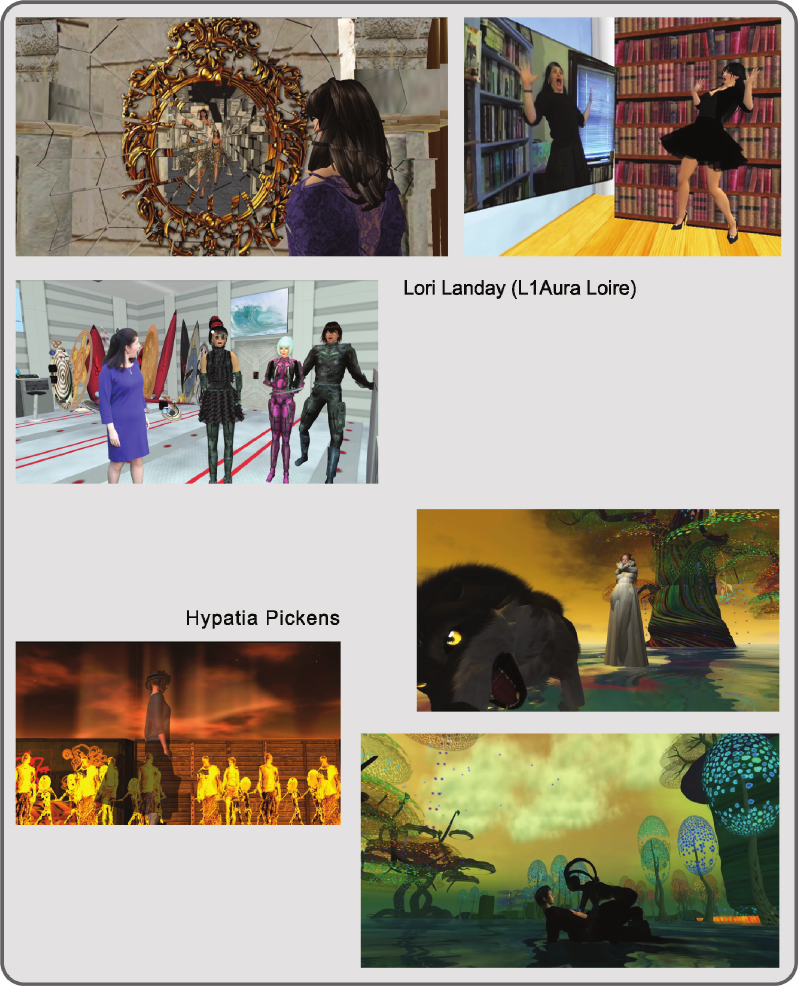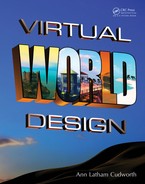315
16
Machinima in Virtual Worlds
One of the most wonderful things in nature is a glance of the eye; it transcends speech; it is the bodily
symbol of identity.
—Ralph Waldo Emerson
16.1 WHAT IS A MACHINIMA?
Machinima (a portmanteau of machine and cinema) is a video art form derived from screen animation
captures in gaming and virtual world environments. 3D game environments and avatars are created or modi-
ed to create settings and actors for these short “movies.” The Association of Machinima Arts and Sciences
denes it as “animated lmmaking within a real-time virtual 3-D environment” [1].
Machinima has a long, rich history that evolved from the videos of the 1980s demoscene computer art
and the 1990s games like Stunt Island, Doom, and Quake. “Quake movies” started to appear when scripts
were added to the movies recorded off the screens of this rst-person shooter game. Machinima’s popular-
ity continues to grow, and most virtual worlds and games offer a modicum of tools to the user that allow
for the recording of screen action. Machinima has appeared in national television shows like South Park,
“MakeLove, Not Warcraft,” in 2006; and CSI: NY, “Down the Rabbit Hole,” episode 405, 2007, to name a
couple of examples.
Second Life and the Linden Endowment for the Arts continually sponsor several machinima festivals.
They have an entire region dedicated to making machinima called the MOSP (Machinima Open Studio
Project), full of prebuilt locations, soundstages, and sets for public use. The MOSP can be visited at
http://maps.secondlife.com/secondlife/LEA7/129/128/21 and followed at http://machinimasl.blogspot.com/.
It is the brainchild of Chic Aeon, one of Second Life’s noted machinimatographers.
16.1.1 The uses of maChinima
From its early uses as a documentation device for “speed runs” through the levels in a rst-person shooter
game, machinima has expanded its usefulness into a broad-range media format.
Figure16.1 (upper half) shows some screen grabs from a machinima Ann Cudworth (Annabelle Fanshaw
in Second Life) created for a campus tour of the Virtual Center for the Science of Cyberspace.
Machinima has demonstrated its place in the teaching of medical, military, and safety procedures; in archi-
tectural and environmental y through; as well as 3D concept presentations.
In the lower half of Figure16.1, you will see some images from “Possibilities,” a machinima about the
display of data in a virtual environment. The machinima was recorded and edited by Ariella Furman (Ariella
Languish in Second Life) at a data-display-driven Art/Sculpture Park built by Annabelle Fanshaw and
Arkowitz Jonson (Ben Lindquist in real life) in 2010.
Machinima has provided a rich source of content and information for scholars and teachers of culture and
media. These are two examples among the many available in this kind of machinima. Frame grabs from three
machinima created by Lori Landay are shown in the top half of Figure16.2. Lori Landay (L1AuraLoire in

316 Virtual World Design
FIGURE 16.1 Screen grabs from OpenSim and Second Life, showing two examples of machinima used for business
purposes. In the top 3 pictures, the “SENDS” proposal machinima by Ann Cudworth (Annabelle Fanshaw in Second
Life) and in the lower three pictures, “Possibilities,” a machinima concieved, designed, and directed by Ann Cudworth,
recorded and edited by Ariella Furman (Ariella Languish in Second Life).

317Machinima in Virtual Worlds
FIGURE 16.2 Still images from machinima by Professor Lori Landay (L1Aura Loire in Second Life) and Professor
Sarah Higley (Hypatia Pickens in Second Life). The top three images are from L1Aura Loire’s works: “Mirror People”
(top left), “Toggle” (top right), and “Transformations” (second row, left). In the lower section are three images from
Hypatia Pickens: “Love Prayer” (top right and lower right) and “Cloud” (left).
318 Virtual World Design
Second Life) is professor of cultural studies at Berklee College of Music in Boston, Massachusetts, where she
teaches visual culture and interactive media studies. She is an interdisciplinary scholar and new media artist
who explores the making of visual meaning in twentieth- and twenty-rst-century culture in her internation-
ally recognized books, articles, and creative digital media. Included are three images from her works: “Mirror
People” (top left), “Toggle” (top right), and “Transformations” (second row, left). All of these machinima are
concerned with the virtual/physical world dichotomy and the reection of ourselves in the virtual avatar.
Below that in the lower half of Figure16.2 is the work of Professor Sarah Higley (Hypatia Pickens in Second
Life). Dr. Higley is an award-winning machinimatographer who is a professor of medieval studies, lm, and
cultural studies at the University of Rochester, New York. Her interests center around northern medieval
languages, Old English, Middle English, Middle Welsh, and lm courses (including machinima). She is uti-
lizing virtual worlds to explore the creation of new media forms. In the lower section are three images from
her work: “Love Prayer” (top right and lower right) and “Cloud” (left).
Machinima has arrived as an art form in its own right. The interface for making movies in Second Life
has been part of the Second Life viewer for years, but now with accelerated graphics cards and large-capacity
storage devices, the tools for sophisticated movie making are available. Virtual world viewers like Firestorm
have upgraded the capacity to provide even faster frame rates for smoother video capture, as well as depth of
eld (DOF) and variable shadow settings.
In the realm of art-based machinima, a couple of notable standouts are Bryn Oh and tutsy NAvArAthnA.
Bryn Oh designs and builds intricate virtual environments based on a loose diary of her experiences, which
incorporate many aspects of technology and fantasy. She then creates machinima from the stories within
that environment. Machinimatographer tutsy NAvArAthnA works in the surreal. His machinima “The Last
Syllable of Recorded Time” won rst place in the 2011 University of Western Australia’s hugely popular
machinima competition. In Figure16.3, you will see screenshots from their work.
There is also some exciting machinima being done by the fashion photographers in virtual worlds.
InFigure16.4 are some images from Tikaf Viper, a noted fashion photographer and machinimatographer in
Second Life.
16.2 DEFINING YOUR NARRATIVE AND PRESENTATION STYLE
The Latin word camera translates as “chamber” or “room.” Therefore, you may take the term rst-person
camera to mean the metaphorical “room” or “point of view” from which you observe a world, real or vir-
tual. If you were outside your body, looking at yourself and everyone else around, you would be using a
“third-person camera” or point of view. These perspectives transition constantly from very personal up-close
inspections to wide vistas full of many visual elements as you focus your virtual camera on the environment
around you. Your interpretations become apparent to other observers when you record these observations
and put them up on a screen as a machinima. Naturally, these visual observations are often accompanied
by words of narrative, as evidenced by the numerous blogs that describe the experience of virtual worlds or
“tell the story.” Figure16.5 shows a diagram of some of the interconnecting elements of your experience in
a virtual world and the modes of storytelling. Essentially, there are two ways to present a story: You can talk
about it (diegesis) or you can show it (mimesis). Both of these are going on simultaneously in most of the
media produced today. In the center is your subjective experience. You see the visual elements in a virtual
world as you observe the architecture, landscape and cultural design, characters of other avatars around you,
and so on. You hear the narrative backstory when the avatars are role-playing, presenting a story, or even
chatting in instant messaging (IM) or local chat. All of this contributes to your temporal and spatial experi-
ences in a virtual world, as well as the various diegetic and nondiegetic elements that enter your awareness.

319Machinima in Virtual Worlds
FIGURE 16.3 Still images from art-based machinima made in Second Life. In the top half are frames from
“VirginiaAlone” (top left) and “Gretchen and Teddy” (bottom right) by Bryn Oh. In the bottom half are frames from
“The Garden of Delights” (top left) and “The Last Syllable of Recorded Time” (bottom right) by tutsy NAvArAthnA.
Also shown in “The Garden of Delights” is the sculptural work by Claudia222 Jewell called Spirit, displayed at Art
Screamer in Second Life.
..................Content has been hidden....................
You can't read the all page of ebook, please click here login for view all page.
